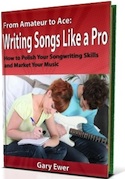Suddenly dropping instruments from the mix can create song energy by increasing anticipation.
____________
Purchase “The Essential Secrets of Songwriting” 6-eBook Bundle, and get this eBook FREE OF CHARGE: “From Amateur to Ace: Writing Songs Like a Pro”.
_____________
 In music, creating a sense of anticipation helps to create energy and momentum and keep listeners hooked. But getting this right is like walking a tight rope. If you put too many elements in your music that are too predictable, it creates boredom as your audience can tell what is going to happen with too much certainty.
In music, creating a sense of anticipation helps to create energy and momentum and keep listeners hooked. But getting this right is like walking a tight rope. If you put too many elements in your music that are too predictable, it creates boredom as your audience can tell what is going to happen with too much certainty.
One way to build a good sense of anticipation is to drop instruments temporarily from the mix. As such, this is not so much a songwriting issue as it is a musical arrangement issue, but there are ways to transfer this effect to your songwriting.
Ebbing and flowing of energy is common in pop music, where instruments are added in a chorus, then taken away for the verses. Ebb and flow is a machine, of sorts, that creates listener interest.
In “Just Give Me a Reason” (Pink ft. Nate Ruess), you hear a long, gradual energy build throughout the song as instruments are added. The build is largely a “straight-line build”, with no spots (at least until the final choruses) where the instrumental energy dissipates to create the normal ebb and flow effect.
Right after the bridge, all instruments are rather unexpectedly dropped, leaving unaccompanied voices with drums. The sudden dropping of instruments from the mix has two rather paradoxical effects: 1) It reduces instrumental energy; and 2) It increases song energy through the listeners’ anticipation of the dropped instruments soon returning.
When the instruments return, it has the effect of boosting the perceived energy of the music even more.
There are other ways that you can incorporate the same kind of principle of ebb and flow at the songwriting level:
- Be sure that the different melodies for the separate sections of your songs explore different ranges, some high (ideally the chorus and bridge) and some low (ideally the verse).
- Be sure your chord progressions use the tonic chord (i.e., the one that represents the key) as an important goal. As the progression moves away from the tonic, anticipation is built; as it approaches the tonic again and then reaches it, energy is released.
- Use verse lyrics to pose questions and describe situations and people, and use the chorus lyric to give an emotional response. Use the bridge to offer a final comment, moving back and forth quickly between lyrics that describe and lyrics that emote.
______________
 Written by Gary Ewer. Follow on Twitter.
Written by Gary Ewer. Follow on Twitter.
Download “The Essential Secrets of Songwriting” 6-eBook Bundle, which currently includes a free copy of “From Amateur to Ace: Writing Songs Like a Pro”.










Pingback: Interesting Links For Musicians and Songwritiers – May 17, 2013 | Creative Music | Inspiring Musical Creativity